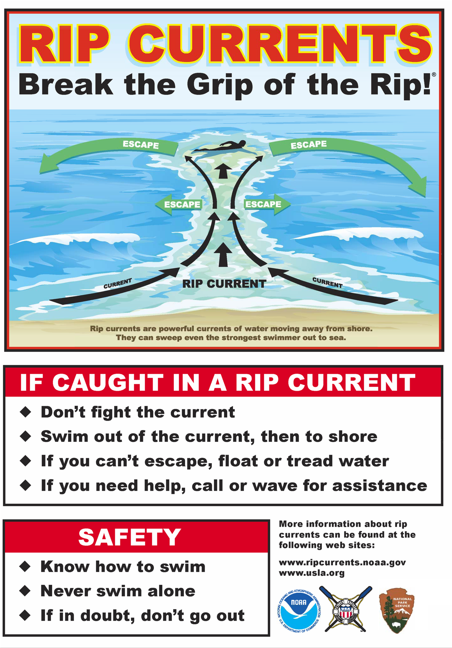Rip currents are one of the most dangerous natural hazards at the beach, responsible for over 80% of lifeguard rescues and approximately 100 drowning deaths annually in the U.S. alone. Despite their prevalence, many beachgoers are unaware of how to identify and escape these powerful currents. This guide will help you recognize rip currents and provide essential tips to stay safe during your beach visits.
🌊 What Is a Rip Current?
A rip current is a narrow, fast-moving channel of water that flows from the shore out to sea. These currents can reach speeds up to 8 feet per second, making them faster than even Olympic swimmers. They form when waves break strongly in some locations and weakly in others, causing a circulation of water that can pull swimmers away from the shore.
👀 How to Spot a Rip Current
Identifying rip currents before entering the water is crucial. Here are some signs to look for:
Breaks in the Wave Pattern: Areas where waves are not breaking, creating a calm appearance amidst breaking waves, may indicate a rip current.
Differences in Water Color: Rip currents can appear darker due to deeper water or lighter due to sand and sediment being pulled from the shore.
Foam and Debris Moving Seaward: Lines of foam, seaweed, or debris moving away from the shore can signal a rip current.
Choppy or Rippled Water: A noticeable difference in water texture, such as a choppy or rippled surface, may indicate a rip current.
It's often easier to spot rip currents from an elevated position, such as a dune or lifeguard tower.
🏊 What to Do If You Get Caught in a Rip Current
If you find yourself caught in a rip current, follow these steps:
Stay Calm: Panic can lead to exhaustion. Remember, rip currents pull you away from shore but not underwater.
Don't Fight the Current: Swimming directly against the current will tire you quickly.
Swim Parallel to the Shore: Escape the narrow current by swimming parallel to the shoreline. Once free, swim back to the beach at an angle away from the current.
Float or Tread Water: If you can't escape, float or tread water until the current weakens, then swim back to shore.
Signal for Help: Wave your arms and yell to attract attention. Lifeguards or bystanders can assist.

🛟 How to Help Someone Caught in a Rip Current
If you see someone in trouble:
Alert a Lifeguard: If available, notify a lifeguard immediately.Reddit+5Ocean Today+5NOAA+5
Call Emergency Services: Dial 911 if no lifeguard is present.Ocean Today
Provide a Flotation Device: Throw a life ring, float, or anything that can help them stay afloat.
Avoid Entering the Water: Unless you're trained and equipped, entering the water can put you at risk.Ocean Today
🏖️ Preventative Measures
To minimize the risk of encountering rip currents:
Swim at Lifeguard-Protected Beaches: Lifeguards can provide information about current conditions and assist in emergencies.
Observe Warning Flags and Signs: Be aware of posted warnings and understand their meanings.
Check Local Forecasts: Before heading to the beach, check for rip current advisories and weather conditions.
Swim with a Buddy: Never swim alone. Having someone with you increases safety.
Know Your Limits: Assess your swimming abilities honestly and avoid venturing too far from shore.
📸 Visual Aids
To better understand rip currents, refer to the following images:

Image Source: National Park Service
Rip currents are a serious hazard but can be survived with knowledge and preparedness. By learning to identify rip currents and understanding how to react if caught, you can enjoy the ocean safely. Always prioritize safety, respect the power of the sea, and educate others about these vital precautions.
 Add Row
Add Row  Add
Add 




 Add Row
Add Row  Add
Add 

Write A Comment